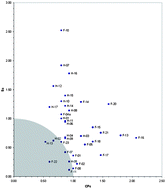Separation system suitability (3S): a new criterion of chromatogram classification in HPLC based on cross-evaluation of separation capacity/peak symmetry and its application to complex mixtures of anthraquinones
Abstract
A comparison of chromatograms obtained in a series of separation conditions for a given complex mixture may be done with a series of chromatographic descriptors. In this study, we used two descriptors: the number of critical pairs and symmetry of peaks, further rescaled and converted to the corresponding critical pairs' coefficient (CPc) and symmetry coefficient (Sc). Considering the difficulty of appreciating global separation quality using CPc and Sc criteria separately, as their respective values are usually uncorrelated, a double-criteria cross-evaluation system was required. For that purpose we tested the commonly used multi-criteria decision-making method – Derringer's desirability function (D) – as well as the recently introduced sum of ranking differences (SRD). To facilitate the graphical comparison of both approaches, the desirability function (D) was used in the inverse form (Dinv). The advantages and drawbacks of both evaluation methods, especially the respective under- or over-evaluation of outliers, caused us to introduce a new ranking approach, separation system suitability (3S). The obtained suitability rankings for the three tested approaches (Dinv, SRD and 3S) are different; nevertheless, 3S appears to be the most balanced and the easiest to interpret as well. The approach developed for selection of suitable systems was applied to the problem of separation of complex mixtures through the analysis of a series of standards of


 Please wait while we load your content...
Please wait while we load your content...